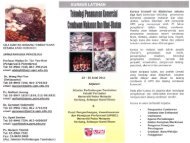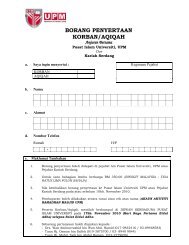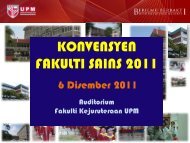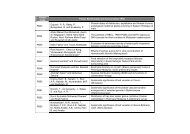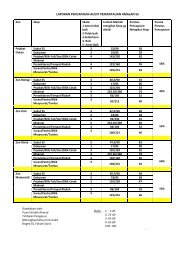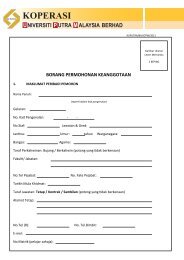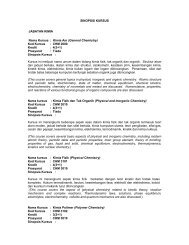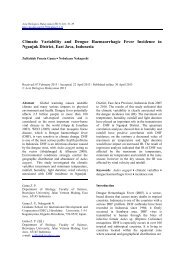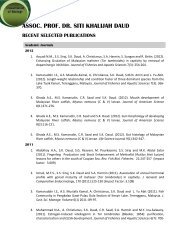Programme Book - UPM - Universiti Putra Malaysia
Programme Book - UPM - Universiti Putra Malaysia
Programme Book - UPM - Universiti Putra Malaysia
You also want an ePaper? Increase the reach of your titles
YUMPU automatically turns print PDFs into web optimized ePapers that Google loves.
P30 DESIGN AND OPTIMISATION OF NANODELIVERYSYSTEM FOR FULLERENE, A POTENT ANTIOXIDANTF.F. Lye, C.L. Ngan, M. Basri*Department of Chemistry, Faculty of Science, <strong>Universiti</strong> <strong>Putra</strong> <strong>Malaysia</strong>, 43400 <strong>UPM</strong>Serdang, Selangor, <strong>Malaysia</strong>Corresponding author:mahiran@science.upm.edu.myFullerene is classified as the third carbon allotrope which was discovered aftergraphite and diamond. Fullerene possesses antioxidant activity which could preventany oxidative stress-related diseases. Due to the hydrophobicity of fullerene,employment of fullerene in cosmetics can be difficult, while altering its structurecould weaken the original antioxidant activity. No research in designing transdermaloil-based nano-emulsion system for fullerene was ever reported. In this study,formulation containing fullerene was prepared by using combination of high energymethods: high shear homogenization and ultrasonication. Response SurfaceMethodology (RSM) based on five-level Central Composite design (CCD) and threelevelBox-Behnken design (BBD) were employed to optimise the conditions forpreparing fullerene nano-emulsions. Interactive effects between palm kernel oilesters:fullerene (12.5-17.5 %), Tween 80:Span 80 (4:1, 6.25-8.75 %), and xanthangum (0.7-0.9 %) concentrations, the homogenization speed (4250-4750 rpm),sonication amplitude (40-60 % amplitude) and sonication time (60-120 s) on theparticle size, zeta potential and viscosity of the colloidal systems were investigated.Results showed that the experimental data could be adequately fitted into secondorderpolynomial models which were validated by excellent evidence in analysis ofvariance (ANOVA). The evidence used includes randomly scattered residuals, high F-values, low P-values, non-significant lack of fit and high regression coefficients. Thesuggested optimum conditions for nano-emulsion preparation having the criteriabased on smallest particle size and highest zeta potential which derived from RSMwere 12.5 % of PKOEs, 7.68 % of surfactant, 0.9 % of xanthan gum, homogenizationspeed of 4750 rpm, 52.5 % sonication amplitude and sonication time for 70 s. Theoptimal formulation was stable against centrifugal force. Further confirmation byeight randomly chosen formulations was carried out and the experimental values werein agreement with the predicted values. The great fit of the models applied led to thesuccess of RSM in optimising the nanodelivery system for fullerene. The optimalformulation showed excellent storage stability at room temperature and 50°C for over3 months as well as in freeze-thaw cycles. The formulation exhibited pseudoplasticbehaviour and was resistant against bacterial growth in the sample.45 |16 th Industrial Chemistry Seminar: Chemistry- A Passport to a Brighter Future




